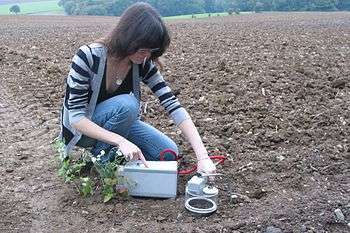Integrated Carbon Observation System
| Abbreviation | ICOS |
|---|---|
| Formation | 2008 |
| Type | Research infrastructure |
| Purpose | Greenhouse gases |
| Website | Integrated Carbon Observation System |

Integrated Carbon Observation System (ICOS) is a new strategic research infrastructure to quantify the greenhouse gas balance in Europe and adjacent regions. It consists of a harmonized network of ecosystem long-term observation sites, a network of atmospheric greenhouse gas concentration sites and a network of ocean observations. The network will be coordinated through a set of central facilities, including an atmospheric and an ecosystem thematic center, a central data center, an analytical laboratory and an oceanic thematic center.
ICOS will provide the essential long-term observations required to understand the present state and predict future behavior of the global carbon cycle and greenhouse gas emissions. It will monitor and assess the effectiveness of carbon sequestration and/or greenhouse gases emission reduction activities on global atmospheric composition levels, including attribution of sources and sinks by region and sector.
Standardized network will improved access to data and enable the development of flux products for research and political application. ICOS will be a state-of-the-art facility for the European research community. It will contribute the European share to global greenhouse gas observations under GEO, WMO-GAW and GTOS programs.
Mission and goals

ICOS aims to build a network of standardized, long-term, high precision integrated monitoring of atmospheric greenhouse gas concentrations. The infrastructure will integrate terrestrial and atmospheric observations at various sites into a single, coherent, highly precise dataset. These data will allow a unique regional top-down assessment of fluxes from atmospheric data, and a bottom-up assessment from ecosystem measurements and fossil fuel inventories. Target is a daily mapping of sources and sinks at scales down to about 10 km, as a basis for understanding the exchange processes between the atmosphere, the terrestrial surface and the ocean. ICOS contributes to the implementation of the Integrated Global Carbon Observation System (IGCO).
Expected impacts
The synergy between the atmospheric concentration measurements, the knowledge of local ecosystem fluxes on the other hand, has shown effective in reducing the uncertainties on carbon assessments. However, in Europe, observatories are all managed differently for each country and data is not homogenously processed. The value added impact of the infrastructure will allow an enhanced visibility and dissemination of European greenhouse gas data and products that are both long-term and carefully calibrated. ICOS seeks to meet the data needs of carbon cycle and climate researchers as well as those of politicians and the general public. ICOS will serve as the backbone to users engaged in developing data assimilation models of greenhouse gas sources and sinks, namely reverse modelling, which allows the deduction of surface carbon flux pattern.
A common data centre, the Carbon Portal put into place by ICOS, will provide free access to ICOS data, as well as to links with inventory data, and outreach material. This portal will allow the production of web based tools for the survey of sources and sinks in near real time. ICOS will deliver the information in near real time with a quantification of the uncertainty associated with the results due to the use of several different models using different methodologies.
ICOS will enable Europe to be a key global player for in situ observations of greenhouse gases, data processing and user-friendly access to data products for validation of remote sensing products, scientific assessments, modelling and data assimilation.
Implementation strategy
The implementation of ICOS will take place in two steps: During the Preparatory Phase starting in 2008 until 2011, the funding commitments will have to be endorsed by the governments and mother institutions, the building of the central facilities will be initiated, and the project will be technically developed up to the level of a demonstration year of full operation, but with a reduced number of observational sites.The ICOS preparatory phase includes 16 research laboratories from 12 European countries, coordinated in France.
During the follow-up Operational Phase from 2012 until 2031, after the full scale deployment of the network, it will be run in an operational mode, and greenhouse gas concentrations and fluxes will be determined on a routine basis.
External links
- ICOS Website
- IGCO
- Carboscope, a website presenting map of fluxes of greenhouse gases
References
- Last news about Carbon budget http://www.globalcarbonproject.org/carbonbudget/07/index.htm